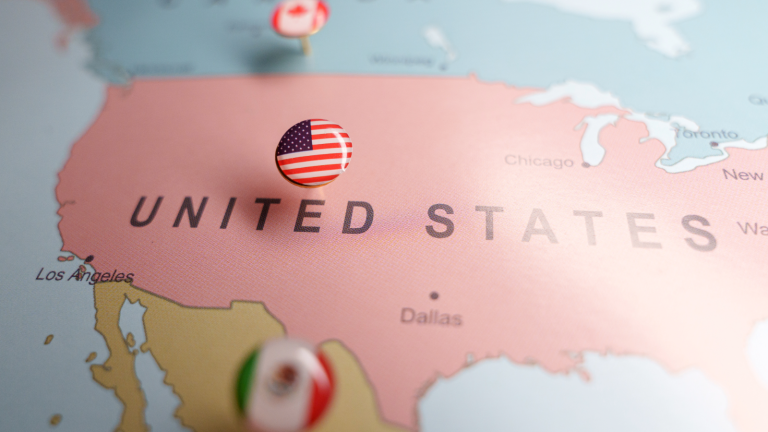Just when the market was starting to regain some upward momentum, President Trump announced another new wave of tariffs. Now stocks are sinking once again.
Indeed, this past Wednesday, March 26, Trump issued a 25% tariff on all cars made outside the United States. That same day, the S&P 500 shed 1%, and the Nasdaq crashed 2%.
As a result, both indices broke a three-day winning streak – their first such streak since the market peaked (and this whole tariff drama began) on Feb. 19.

With these auto tariffs… and even more to come next week – Wednesday, April 2; what Trump is calling “Liberation Day” and “the big one” – we could be on the cusp of a global trade war bigger than anything we’ve seen in the past 100 years.
We think it’s time to prepare for that potential outcome.
The Stakes Are Rising
A 25% tariff on all imported vehicles is significant.
Estimates vary. But generally speaking, about 50% of cars purchased by Americans are made in the U.S., and 50% are made abroad – a roughly equal split. That means 1 out of every 2 cars bought in America is now subject to a 25% tariff.
If all those costs pass through to the consumer, then 1 in every 2 cars will now be 25% more expensive. As Newsweek estimates, “the tariffs could raise vehicle prices by as much as $12,500… With average prices already near $49,000, many households may be priced out of the new car market.”
That’s a big deal. And it may be just the tip of the iceberg here…
Because 25% tariffs on most Mexican and Canadian goods are also set to resume next week.
These are two of America’s three biggest trading partners. Together, they import about $900 billion worth of goods into the U.S., including lots of household appliances, air conditioners, electrical components, surgical equipment, fresh produce, beer, oil, natural gas, timber, aluminum, and grains. In other words… just about everything.
All those goods and supplies will now be subject to a 25% tariff, potentially making them 25% more expensive to buy.
Not to mention, Trump is expected to enforce multiple reciprocal tariffs against major U.S. trading partners, such as the European Union, India, and others.
Those could dramatically disrupt global trade flows and create huge production bottlenecks…
Will Tariffs Be More Bark Than Bite?
So, yes, don’t let the mainstream media or political rhetoric fool you – these tariffs are a big deal. And everything comes to a head next week, on Wednesday, April 2.
But the question is – will things stick?
So far, very few tariffs have remained in play. For the most part, despite an avalanche of threats, the only tariffs that have stuck are some additional levies on Chinese goods.
There’s an identifiable pattern here:
- In early February, less than 24 hours after Trump first announced sweeping tariffs against Canada and Mexico, all three countries came to a deal to delay those proposed tariffs.
- Less than 24 hours after Trump paused all military aid to Ukraine, reports leaked that the two came to an agreement to sign an overdue minerals deal that would resume aid.
- Less than 24 hours after Trump actually did enforce sweeping tariffs against Canada and Mexico, reports leaked that the three were working on a deal to remove some or all of them.
It seems that Trump is only using tariffs as a strong-arm negotiation tactic to reach better trade deals for the U.S. We don’t think he intends to keep them in place.
But of course, there’s no way to know for certain. All these tariffs coming next week could stick around.
And if they do, it could spell major trouble for the markets.
Tariffs Have Already Slammed Stocks
Just look at how much damage tariffs have already caused on Wall Street so far.
The S&P is off to its worst start to a year since 2022, when stocks nosedived into a bear market on runaway inflation fears.
It crashed 10% in just 20 days for the fifth-fastest correction in the market’s history. And it lost its primary uptrend line – the 200-day moving average – for just the second time since this bull market began in early 2023.

And this has been the result of small and temporary tariffs. What happens if next week’s tariffs stick around?
The tariffs imposed so far have caused the fifth fastest 10% stock market crash in history. What damage will big, long-lasting tariffs cause?
The Final Word
Things could get ugly, folks. Risks are rising.
But, as we said, considering Trump’s pattern of behavior, these tariff threats could very well be much more bark than bite.
So…
While Trump’s trade war could cause a global recession and plunge stocks into a bear market… it likely won’t.
And the fears that it might have led stocks lower, creating what could be a fantastic buying opportunity.
What’s the best way to capitalize on it?
Well, as we mentioned recently, the AI trade is the most likely to offer a safe haven – even profits within a broader selloff – if things take a turn for the worst.
Bloomberg’s Artificial Intelligence Aggregate index (BAIAET) is a strong proxy for the sector at large. It currently stands at major technical support levels (the 250-day moving average) that it hasn’t yet broken. Additionally, at 21X forward P/E, it’s trading at its lowest valuation since its inception, all while estimates for AI companies are still rising like crazy…

Whether you’re looking for security or surplus, it seems that AI is the way to go.
But the broader AI trade is crowded. That’s why we’ve been hunting for the next big industry breakthrough…
And we’ve found it in what I call AI 2.0 – a development that could be an order of magnitude bigger than anything we’ve seen in the AI Boom so far.
On the date of publication, Luke Lango did not have (either directly or indirectly) any positions in the securities mentioned in this article.
P.S. You can stay up to speed with Luke’s latest market analysis by reading our Daily Notes! Check out the latest issue on your Innovation Investor or Early Stage Investor subscriber site.

